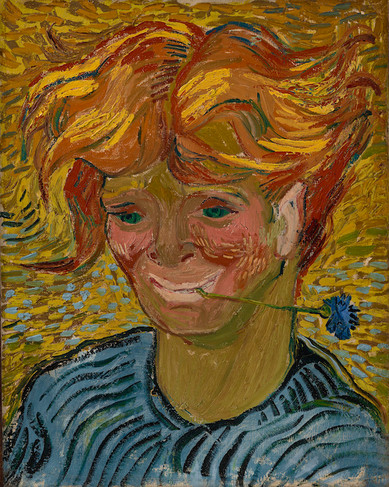In November the members of our London gallery were offered the fantastic opportunity to visit the newly opened Van Gogh House in South London. So closely was Vincent Van Gogh associated with Harry Gladwell, the son of one of the Gladwell Brothers, that the director of the house, Livia Wang, reached out to us to offer a tour. We’re hoping that this visit is going to form part of a wider investigation into the links between the gallery and Van Gogh during our 270th year celebrations.
Our collective mental image of Van Gogh tends to be populated with starry skies, sunflowers, and the south of France, but at 87 Hackford Road in Brixton the Van Gogh House captures a very different side of his life. Given that perhaps the most famous artistic personality of the late nineteenth-century spent over four years of his twenties staying in the London, it seems surprising how little attention is given to this time in the city – hopefully this is now set to change.
Now a typical looking Georgian terrace, when these properties were built in the 1820s they faced onto fields and undeveloped land (Vincent wrote about having to cross fields on his walks into central London). Originally intended for a single family, the building was quickly divided into single room lets, the conditions that Vincent found it in when lodging there for a year. Having served at times as a schoolhouse, a family home and a boarding house, the association with Van Gogh was quickly forgotten. While the house narrowly escaped demolition during the blitz, it fell into significant disrepair during the latter half of the twentieth century, and this was the state in which it was purchased by its current owners, the Wang family. From 2012 until 2019 they have been studying, repairing, and conserving the house.
The primary reason for turning 87 Hackford Road into a museum is of course its role in housing Van Gogh on his first visit to London. Aged twenty, and four years into his career as an art dealer, Vincent found himself far from his family in what was at the time the world’s largest city. In his many letters to his brother Theo he recounted his London life. From the mundanity of evening meals to the drama of a possible affair with his landlord’s daughter, Van Gogh mixed his intense temperament with the excitement of the young adult in funny and often touching ways – I’d recommend his letters to anyone for a slice of daily life and experience 150 years ago. Van Gogh was an art dealer for far longer than he was an artist, only painting in his immediately recognisable style for the last three years of his life, and the majority of his life was spent living in city houses just like this one.
All of this and more was recounted by Living Wang, the head of the museum, who was an extremely generous host whose clear passion for not only Van Gogh but the two hundred years of inhabitants lent itself to a fantastic tour. While we had expected our visit to largely focus on the artist, we were instead greeted by a much larger project - a museum of the intersecting narratives of its two centuries of occupants. From the toys and handwriting practice notes of a young boy who had lived there in the 1840s, to the lino ceilings of its final resident, the house interweaves stories from the lives of normal Londoners.
The interior of the house itself is an impressive exercise in mixing stylish and thoughtful design with an inherently historical setting. One of the reasons that the house gives off such unique character is the role that artists have played in its decoration, each year the Van Gogh House offers residence to a host of different creatives. Echoing Vincent’s experience 150 years ago, artists still stay in his room, and each of the rooms bears the marks of recent residents. Livia has also put significant effort into historical realism with the design of the house. In fact, on the morning of our visit she pulled up to meet us having just bought two vintage doorknobs at a south London antiques auction at nine in the morning!
The house is now open to visitors by appointment, and I would strongly recommend a visit – from design to history to Van Gogh himself, there is a wealth of interest to be found there. We hope to continue our relationship with the house, particularly as we investigate our links with the great artist. As a small taster for our next Van Gogh blog, I’ll leave you with the artist’s description of his best English friend, Harry Gladwell:
“Thin as a stick with two rows of strong teeth, full red lips, a pair of large red protruding ears and close-cropped hair. At first everyone laughed at him… even I”







Comments